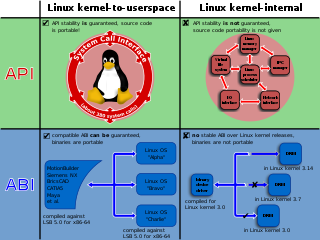Related Research Articles

In computing, the Executable and Linkable Format is a common standard file format for executable files, object code, shared libraries, and core dumps. First published in the specification for the application binary interface (ABI) of the Unix operating system version named System V Release 4 (SVR4), and later in the Tool Interface Standard, it was quickly accepted among different vendors of Unix systems. In 1999, it was chosen as the standard binary file format for Unix and Unix-like systems on x86 processors by the 86open project.

Security-Enhanced Linux (SELinux) is a Linux kernel security module that provides a mechanism for supporting access control security policies, including mandatory access controls (MAC).
A Berkeley (BSD) socket is an application programming interface (API) for Internet domain sockets and Unix domain sockets, used for inter-process communication (IPC). It is commonly implemented as a library of linkable modules. It originated with the 4.2BSD Unix operating system, which was released in 1983.

DragonFly BSD is a free and open-source Unix-like operating system forked from FreeBSD 4.8. Matthew Dillon, an Amiga developer in the late 1980s and early 1990s and FreeBSD developer between 1994 and 2003, began working on DragonFly BSD in June 2003 and announced it on the FreeBSD mailing lists on 16 July 2003.
Capability-based security is a concept in the design of secure computing systems, one of the existing security models. A capability is a communicable, unforgeable token of authority. It refers to a value that references an object along with an associated set of access rights. A user program on a capability-based operating system must use a capability to access an object. Capability-based security refers to the principle of designing user programs such that they directly share capabilities with each other according to the principle of least privilege, and to the operating system infrastructure necessary to make such transactions efficient and secure. Capability-based security is to be contrasted with an approach that uses traditional UNIX permissions and Access Control Lists.

chroot is an operation on Unix and Unix-like operating systems that changes the apparent root directory for the current running process and its children. A program that is run in such a modified environment cannot name files outside the designated directory tree. The term "chroot" may refer to the chroot(2) system call or the chroot(8) wrapper program. The modified environment is called a chroot jail.
In Unix and Unix-like computer operating systems, a file descriptor is a process-unique identifier (handle) for a file or other input/output resource, such as a pipe or network socket.

In some operating systems, including Unix-like systems, a pseudoterminal, pseudotty, or PTY is a pair of pseudo-device endpoints (files) which establish asynchronous, bidirectional communication (IPC) channel between two or more processes.
Unix-like operating systems identify a user by a value called a user identifier, often abbreviated to user ID or UID. The UID, along with the group identifier (GID) and other access control criteria, is used to determine which system resources a user can access. The password file maps textual user names to UIDs. UIDs are stored in the inodes of the Unix file system, running processes, tar archives, and the now-obsolete Network Information Service. In POSIX-compliant environments, the shell command id gives the current user's UID, as well as more information such as the user name, primary user group and group identifier (GID).

The Linux kernel provides multiple interfaces to user-space and kernel-mode code that are used for varying purposes and that have varying properties by design. There are two types of application programming interface (API) in the Linux kernel:
- the "kernel–user space" API; and
- the "kernel internal" API.
The jail mechanism is an implementation of FreeBSD's OS-level virtualisation that allows system administrators to partition a FreeBSD-derived computer system into several independent mini-systems called jails, all sharing the same kernel, with very little overhead. It is implemented through a system call, jail(2), as well as a userland utility, jail(8), plus, depending on the system, a number of other utilities. The functionality was committed into FreeBSD in 1999 by Poul-Henning Kamp after some period of production use by a hosting provider, and was first released with FreeBSD 4.0, thus being supported on a number of FreeBSD descendants, including DragonFly BSD, to this day.
seccomp is a computer security facility in the Linux kernel. seccomp allows a process to make a one-way transition into a "secure" state where it cannot make any system calls except exit , sigreturn , read and write to already-open file descriptors. Should it attempt any other system calls, the kernel will either just log the event or terminate the process with SIGKILL or SIGSYS. In this sense, it does not virtualize the system's resources but isolates the process from them entirely.
In computing, ioctl is a system call for device-specific input/output operations and other operations which cannot be expressed by regular file semantics. It takes a parameter specifying a request code; the effect of a call depends completely on the request code. Request codes are often device-specific. For instance, a CD-ROM device driver which can instruct a physical device to eject a disc would provide an ioctl request code to do so. Device-independent request codes are sometimes used to give userspace access to kernel functions which are only used by core system software or still under development.
A network socket is a software structure within a network node of a computer network that serves as an endpoint for sending and receiving data across the network. The structure and properties of a socket are defined by an application programming interface (API) for the networking architecture. Sockets are created only during the lifetime of a process of an application running in the node.
The Berkeley Packet Filter is a network tap and packet filter which permits computer network packets to be captured and filtered at the operating system level. It provides a raw interface to data link layers, permitting raw link-layer packets to be sent and received, and allows a userspace process to supply a filter program that specifies which packets it wants to receive. For example, a tcpdump process may want to receive only packets that initiate a TCP connection. BPF returns only packets that pass the filter that the process supplies. This avoids copying unwanted packets from the operating system kernel to the process, greatly improving performance. The filter program is in the form of instructions for a virtual machine, which are interpreted, or compiled into machine code by a just-in-time (JIT) mechanism and executed, in the kernel.
In Unix-like operating systems, a device file, device node, or special file is an interface to a device driver that appears in a file system as if it were an ordinary file. There are also special files in DOS, OS/2, and Windows. These special files allow an application program to interact with a device by using its device driver via standard input/output system calls. Using standard system calls simplifies many programming tasks, and leads to consistent user-space I/O mechanisms regardless of device features and functions.

The Linux kernel is a free and open source, UNIX-like kernel that is used in many computer systems worldwide. The kernel was created by Linus Torvalds in 1991 and was soon adopted as the kernel for the GNU operating system (OS) which was created to be a free replacement for Unix. Since the late 1990s, it has been included in many operating system distributions, many of which are called Linux. One such Linux kernel operating system is Android which is used in many mobile and embedded devices.
ptrace is a system call found in Unix and several Unix-like operating systems. By using ptrace one process can control another, enabling the controller to inspect and manipulate the internal state of its target. ptrace is used by debuggers and other code-analysis tools, mostly as aids to software development.
"Everything is a file" is an idea that Unix, and its derivatives, handle input/output to and from resources such as documents, hard-drives, modems, keyboards, printers and even some inter-process and network communications as simple streams of bytes exposed through the filesystem name space. Exceptions include semaphores, processes and threads.
Entropy-supplying system calls are system calls in Unix-like operating system kernels through which processes can obtain entropic or random data. The first of these was getentropy, introduced to the OpenBSD operating system in release 5.6, as a refactoring of the sysctl(3) KERN_ARND approach used since 1997. Linux offers a very similar system call, getrandom, which was based on getentropy. It was first available in Linux 3.17, released in October 2014. In July 2015, Solaris introduced slightly modified versions of getentropy and getrandom. In August 2015, FreeBSD introduced the read_random system call for obtaining random data from the kernel.
References
- ↑ "Capsicum: practical capabilities for UNIX". Cambridge Computer Laboratory. Retrieved 8 April 2020.
- ↑ Watson, Robert N. M. (2012). "New approaches to operating system security extensibility". Cambridge Computer Laboratory. doi:10.48456/tr-818 . Retrieved 1 April 2024.
- ↑ Edge, Jake (February 22, 2012). "Capsicum: practical capabilities for UNIX". lwn.net.
- 1 2 "NuxiNL/cloudabi". Nuxi. 30 March 2020.
- ↑ Brown, Neil (February 10, 2016). "CloudABI". lwn.net.